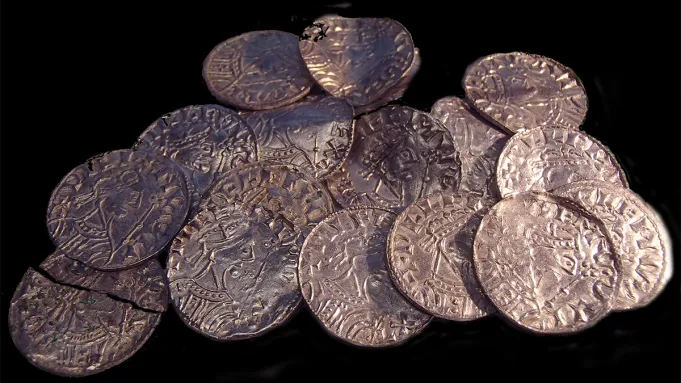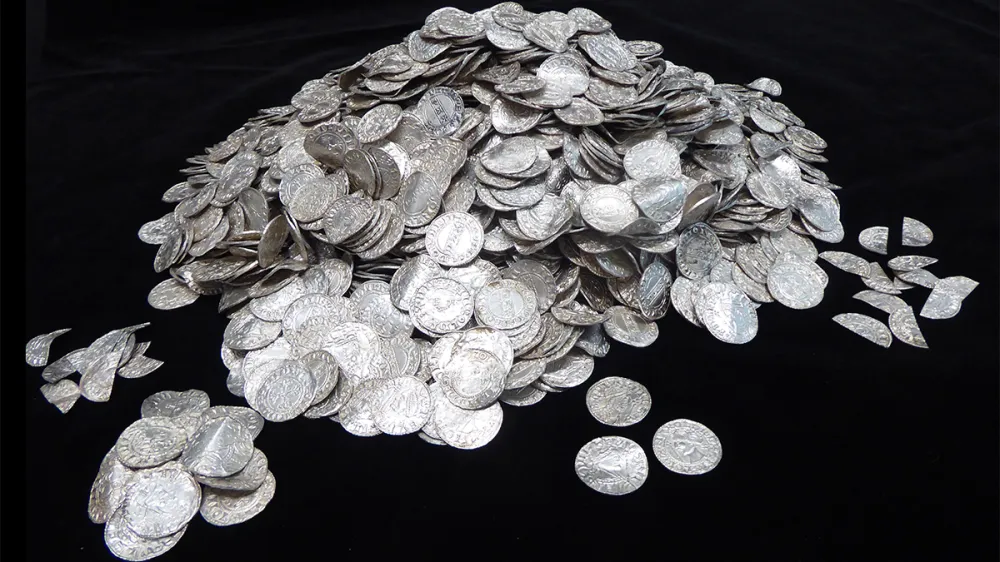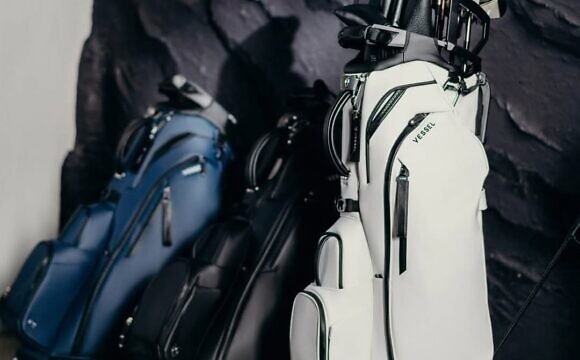กองสมบัติขนาดใหญ่ของเหรียญเงินอายุ 1,000 ปีที่พบโดยกลุ่มคนที่กำลังเรียนรู้วิธีใช้เครื่องตรวจจับโลหะในปี 2019 ได้รับการประเมค่ามูลค่าล่าสุดที่ 5.6 ล้านดอลลาร์ (4.3 ล้านปอนด์) ทำให้เป็นสมบัติที่มีค่าที่สุดในอังกฤษ
ในเดือนมกราคม 2019 ผู้ที่มีเครื่องตรวจจับโลหะเจ็ดคน “ในการเดินทางไปยังทุ่งเปียก ๆ” พบเหรียญ 2,584 เหรียญในพื้นที่ Chew Valley ของ Bath and North East Somerset คนกลุ่มนี้ใช้เวลาสี่ถึงห้าชั่วโมงในการขุดกองสมบัติ ถึงแม้ว่าจะถูกขัดขวางโดยพายุฝนฟ้าคะนองครั้งใหญ่ “เราไม่ได้ออกจากไซต์จนกว่าเราคิดว่าเราได้เหรียญทั้งหมด” Adam Staples หนึ่งในผู้พบกล่าวกับ Derby Telegraph ในปี 2019 “พวกเราเปียกมากตอนที่ทุกอย่างเสร็จสิ้น”
ข่าวประชาสัมพันธ์จาก British Museum เรียกเหรียญที่พบนี้ว่า Chew Valley hoard ตามสถานที่ที่และกว่าการค้นพบครั้งนี้ “เป็นหนึ่งในสิ่งที่น่าทึ่งที่สุดที่รายงานภายใต้พระราชบัญญัติสมบัติ 1996”
กองสมบัติประกอบด้วยเหรียญของกษัตริย์ Harold II กษัตริย์แองโกล-แซ็กซอนคนสุดท้ายของอังกฤษ และเหรียญของ William the Conqueror จากสมัยการพิชิตของชาวนอร์มัน (1066–1068 AD) กลุ่มนี้รายงานการค้นพบครั้งแรกต่อเจ้าหน้าที่ติดต่อท้องถิ่นซึ่งเป็นส่วนหนึ่งของโครงการ Portable Antiquities Scheme ของ British Museum ซึ่งบันทึกการค้นพบทางโบราณคดีที่ทำโดยสมาชิกของสาธารณชนและยังจัดการรายงานท้องถิ่นของรายการที่ตกอยู่ภายใต้พระราชบัญญัติสมบัติ
เมื่อวันที่ 22 ตุลาคม South West Heritage Trust ประกาศว่าได้ซื้อกองเหรียญเงิน “ที่ไม่เคยมีมาก่อน” ผ่านการระดมทุนครั้งใหญ่ รวมถึงเงินทุนจาก National Lottery Heritage Fund และ Art Fund
South West Heritage Trust ได้รับเงินทุนมากกว่า 4.4 ล้านปอนด์ (5.7 ล้านดอลลาร์) จาก National Lottery Heritage Fund และ 150,000 ปอนด์ (195,000 ดอลลาร์) จาก Art Fund สำหรับการซื้อและโครงการมีส่วนร่วมที่เกี่ยวข้อง ข่าวประชาสัมพันธ์จาก British Museum ระบุว่า South West Heritage Trust “จะสามารถขอรับเงินทุนเพิ่มเติมในภายหลังสำหรับโครงการมีส่วนร่วมและการจัดแสดงกองสมบัติอย่างถาวรที่พิพิธภัณฑ์ Somerset”
“มันยอดเยี่ยมอย่างน่าเหลือเชื่อ” Staples บอกกับ The Guardian เมื่อวันที่ 21 ตุลาคม “มันเป็นความรู้สึกที่น่าทึ่ง ในการค้นหาเหรียญหนึ่งเหรียญ จากนั้นภายในไม่กี่นาทีก็มีอีกสองสามเหรียญ แล้ว 10 เหรียญ 50 เหรียญ มันเพิ่มขึ้นเรื่อย ๆ และเหมือนอารมณ์มันจะทวีคูณไปตามนั้น มันเปลี่ยนชีวิตของฉันอย่างแน่นอน มันเหมือนกับถือประวัติศาสตร์ไว้ในมือ และเห็นได้ชัดว่าด้านการเงินก็ยอดเยี่ยมเช่นกัน"
ครึ่งหนึ่งของรายได้จะไปถึงผู้ค้นหาเจ็ดคนในขณะที่อีกครึ่งหนึ่งจะไปถึงเจ้าของที่ดินของทุ่งนา ซึ่ง The Guardian รายงานว่าไม่ได้ระบุชื่อ “เราทุกคนตกลงที่จะแบ่งปันและเราก็พอใจกับข้อตกลง” Staples กล่าวซึ่งดำเนินการขายทอดตลาดที่เชี่ยวชาญด้านเหรียญโบราณ
ในปี 2019 Staples บอกกับ Daily Telegraph ว่าหากเหรียญเหล่านี้ถูกประกาศว่าเป็นสมบัติอย่างเป็นทางการ รายได้จะ “เปลี่ยนแปลง” ชีวิตของเขาและ Lisa Grace คู่หูของเขาอย่างสิ้นเชิง “เราจะสามารถซื้อทรัพย์สินของเราเอง—มันคืออิสรภาพ!"
เหรียญจะถูกจัดแสดงที่ British Museum ในวันที่ 26 พฤศจิกายน ก่อนที่จะจัดแสดงที่พิพิธภัณฑ์อื่น ๆ ในสหราชอาณาจักร โดยมีจุดหมายปลายทางสุดท้ายที่พิพิธภัณฑ์ Somerset
จากบทความโดย Karen K. Ho for ARTnews

Courtesy of The British Museum
A massive hoard of 1,000-year-old silver pennies found by a group of people learning how to use metal detectors in 2019 were recently valued at $5.6 million (£4.3 million), making it the highest-valued treasure in England.
In January 2019, seven people with metal detectors “on a speculative trip to a soggy field" found the 2,584 coins in the Chew Valley area of Bath and North East Somerset. The group spent four to five hours digging up the hoard and were not deterred by a massive thunderstorm. “We didn’t leave the site until we thought we’d got all the coins," Adam Staples, one of the finders, told the Derby Telegraph in 2019. “We were soaking wet by the time we finished."
A press release from the British Museum called the pennies, also known as the Chew Valley hoard for where they were found, “one of the most remarkable finds reported under the Treasure Act 1996".
The hoard consists of King Harold II pennies, the last Anglo-Saxon king of England, and William the Conqueror coins from the time of the Norman Conquest (1066–1068 AD). The group first reported the find to a local liasons officer as part of the British Museum’s Portable Antiquities Scheme, which records archaeological finds made by members of public and also handles local reports of items that fall under the Treasure Act.
On October 22, the charity South West Heritage Trust announced it had acquired the “unprecedented" hoard of silver pennies through major funding, including grants from the National Lottery Heritage Fund and Art Fund.
The charity was awarded a grant of more than £4.4 million ($5.7 million) by the National Lottery Heritage Fund and £150,000 ($195,000) from Art Fund for the acquisition and associated engagement project. A press release from the British Museum noted the South West Heritage Trust “will be able to apply for a further grant at a later date for an engagement programme and the permanent display of the hoard at the Museum of Somerset."
“It’s fantastic, unbelievable," Staples told The Guardian on October 21. “It was a feeling of amazement. To find one coin was great. Then within a few minutes a few more, then 10 coins, 50 coins. It was ever increasing. And your emotions are just multiplying. It has definitely changed my life. It was like holding history in your hand. And, obviously, the financial side of it is brilliant as well."
Half the proceeds will go to the seven finders while the other half will go to the landowner of the field, who the Guardian reported is not being named. “We all agreed to share it and we’re all happy with the agreement," said Staples, who runs an auction house specializing in ancient coins.
In 2019, Staples told the Daily Telegraph that if the coins were declared an official treasure, the proceeds would “totally change" life for him and his partner Lisa Grace. “We will be able to buy our own property—it’s freedom!"
The coins will go on display at the British Museum on November 26 before being exhibited at other museums in the U.K., with their final destination at the Museum of Somerset.
From the article by Karen K. Ho for ARTnews








